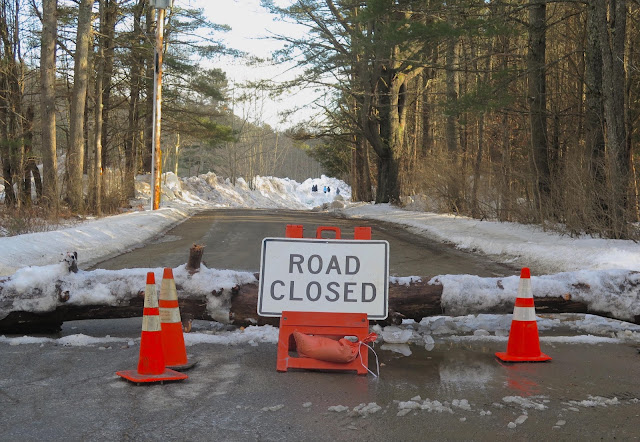Has it really been ONLY two weeks since I've posted a blog? It sure seems a lot longer to me, since most of these past two weeks I've been feeling quite sick, with abdominal pain, headache, nausea, chills, fatigue, etc., which made each day pass very slowly. Especially since I wasn't getting out to the woods for the healing benefits of nature walks. I'm still feeling shaky, but since medical tests now have ruled out anything terminal or treatable, I've decided to act as IF I were healthy, and maybe the trick will work.
Not yet up for a hike but quite capable of an hour's drive, I drove up to the Ice Meadows along the Hudson River yesterday, eager to witness the reports of ice jams and road blockages happening along the river north of Warrensburg. This turbulent stretch of the Hudson is known for the monumental heaps of a particular frothy ice called "frazil" that mount to towering heights, occasionally damming the river and pushing right across riverside roads -- which I had heard had happened again this past week.
As I drove north out of Warrensburg along Golf Course Road, I noted significant -- but not astounding -- heaps of frazil piled on the river's shore and a few signs of where it previously had mounted to the road's guard rails. But all appeared to have retreated back to the normal banks now, with the churning floe-and frazil-filled water coursing freely along. I had read that ice jams had caused flooding of the bridge across the Hudson at Thurman, but I noticed no signs of impeded flow or flooding along this stretch just downstream from where Rte. 28 crosses the Hudson at The Glen.
Here's a view of the Hudson upstream from the bridge at The Glen. It is here in this very turbulent stretch of the river that much of the frazil ice forms, when the turbulence tosses droplets of super-cooled water into sub-freezing air, where the droplets immediately freeze and fall into the water, congealing with other frozen droplets to form slushy pans of frothy ice that eventually collect into masses that build down to the river bottom and eventually dam the river's flow. The river then rises, carrying the frazil heaps onto the shore. Eventually, the current's force re-opens the flow and the river then falls, leaving the frazil deposited on the shore. What look like banks of snow along the river here are actually heaps of frazil ice.
The current today was roiling and rowdy, carrying chunks of translucent solid ice (formed in still water) as well as slushy rafts of frazil washing downstream. Since the temperature was above freezing now, no new frazil was forming, and recent rains had swollen the flow of water.
The view downstream from The Glen. The river was thick with chunks of ice, but the current was flowing freely. Since all looked to be normal here, with the river well within its banks, I decided to take the west-bank river road back toward Warrensburg. I was hoping, of course, that the Thurman Bridge was now above water.
Road crews have been working for days to open the road, with stretches yet to complete. A few other folks had also come to witness the phenomenon of such monumental frazil deposits.
I continued walking along the cleared section of road, marveling at the amount of frazil heaped alongside.
I DO want to emphasize, that as destructive as these surging heaps of frazil ice may be to human convenience, that same ice is essential for creating the Ice Meadows habitat along these Hudson shores, suppressing woody growth and discouraging invasion by non-native plant species, allowing many rare native plants to thrive and persist, some of which are known to exist in few or no other places in New York State. To get an impression of just how botanically rich this Ice Meadows site is, I invite you to visit this blogpost that records a recent summertime visit.











Thanks for the post. I hope you'll feel better.
ReplyDeleteThat's quite the flow in that river, and fascinating ice! Sorry you've been feeling ill. I've been feeling (mostly) good, but I still can't get out in the woods. Did get out for coffee today!
ReplyDeleteFascinating sequence -- it's interesting that there are no other areas where the same community of plants has developed in places where ice or high water scour the shoreline gravel. Glad you can get out again, at our age recovering from anything takes a lot longer.
ReplyDelete